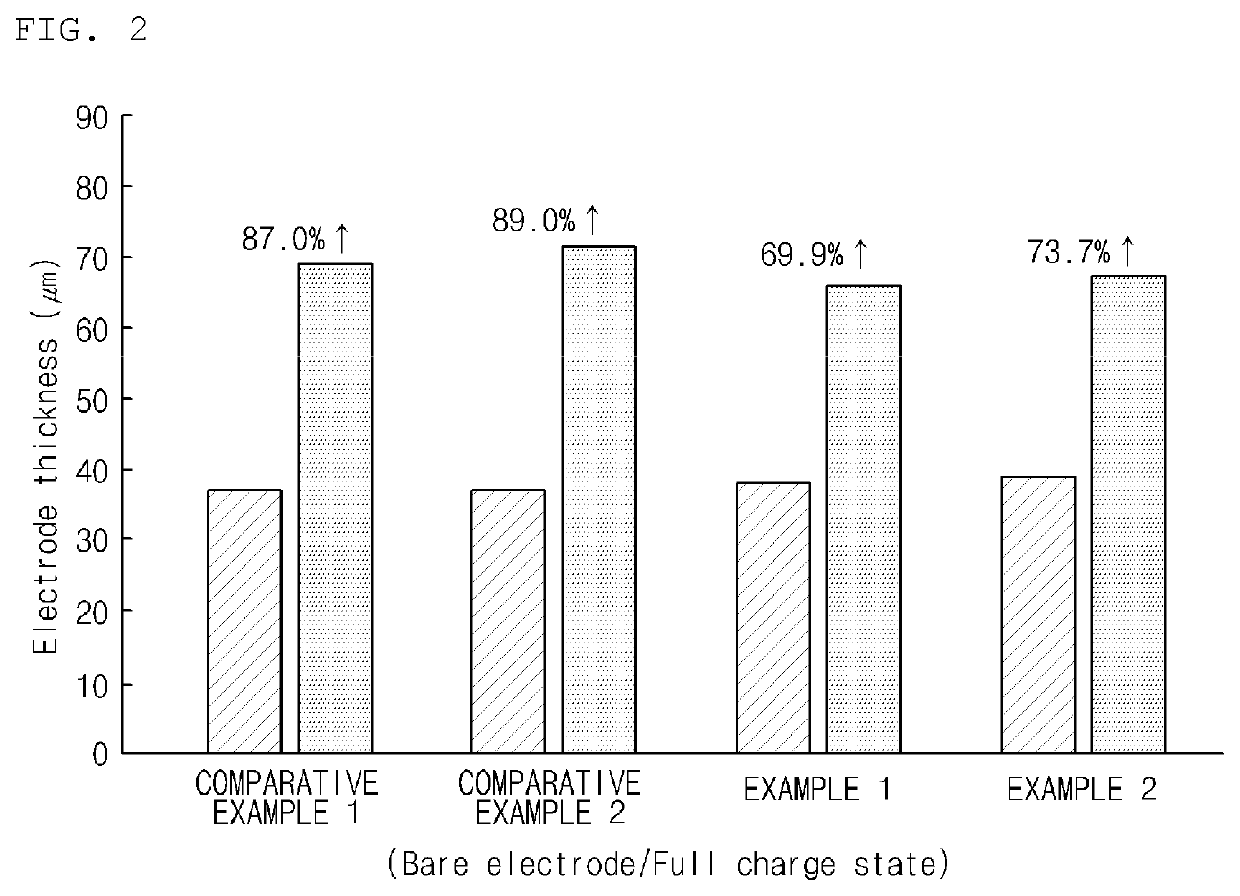Binder for secondary battery electrode, secondary battery electrode and secondary battery including same, composition for secondary battery electrode for producing said secondary battery electrode, and method for producing said secondary battery electrode
a secondary battery and electrode technology, applied in the direction of electrode manufacturing process, cell components, electrochemical generators, etc., can solve the problems of deterioration excessive volume expansion, and high consumption of electrode active material and battery, so as to improve the efficiency of a secondary battery, reduce the resistance of the electrode, and improve the conductivity of the electrod
- Summary
- Abstract
- Description
- Claims
- Application Information
AI Technical Summary
Benefits of technology
Problems solved by technology
Method used
Image
Examples
preparation example
Preparation of Copolymer
[0083]26.7 g of methyl acrylate and 53.3 g of poly(vinylalcohol) were dissolved in 320 g of benzene and stirred in a 1 L reaction container equipped with a heater, a condenser, and a stirrer. 2.256 g of benzoyl peroxide was added as an initiator and 16.8 g of 1-butanethiol was added as a chain transfer reactant. Temperature was raised to 110° C. in a nitrogen atmosphere. After a reaction time of 4 hours, the initiator and the monomer were washed with methanol, and the resulting powder was stirred in an excessive amount of n-hexane. An excessive amount of 5N NaOH solution was added into the solution being stirred, and then, the methyl in the methyl acrylate was substituted with a Na ion by stirring for 2 hours. After the reaction, the mixture was sedimented to obtain a powder, and then, the obtained powder was dried in an oven at 60° C. to obtain a final synthesized copolymer.
[0084]The weight average molecular weight of the prepared copolymer was 360,000, and ...
example 1
Manufacture of Composition for Secondary Battery Electrode, Binder for Secondary Battery Electrode, Secondary Battery Electrode, and Secondary Battery
[0087](1) Preparation of Composition for Secondary Battery Electrode
[0088]4.21 g of the copolymer prepared in Preparation Example was added to 79.99 g of water, and mixed at 70° C. and 1500 rpm by using a homomixer for 180 minutes to prepare 5.0 wt % copolymer dispersion solution in which the copolymer was dispersed. 1.25 g of a carbon black-based conductive material and 70.8 g of water were added to 12.21 g of the dispersion solution, and the mixture was dispersed by using a homomixer. 150.0 g of artificial graphite (negative electrode active material) having 20 μm was added to the dispersed solution, and mixed at 45 rpm by using a planetary mixer for 40 minutes. Thereafter, 0.47 g of diglycidyl ether (molecular weight: 500 g / mol), which is a cross-linking agent, was added to the mixed solution, and mixed at 45 rpm by using a planetar...
example 2
Manufacture of Composition for Secondary Battery Electrode, Binder for Secondary Battery Electrode, Secondary Battery Electrode, and Secondary Battery
[0096](1) Preparation of Composition for Secondary Battery Electrode
[0097]A composition for a secondary battery electrode was prepared in the same manner as in Example 1 except that the total amount of 94.35 g of the copolymer dispersion solution (3.74 g of total copolymer) and 0.94 g of the cross-linking agent were added. The prepared composition for a secondary battery electrode was a mixed solution (solid content of 48.0 wt %) in which the negative electrode active material, the conductive material, the copolymer, and the cross-linking agent were mixed at a weight ratio of 96.2:0.8:2.4:0.6.
[0098](2) Production of Binder for Secondary Battery Electrode, Secondary Battery Electrode, and Secondary Battery
[0099]A binder for a secondary battery electrode, a secondary battery electrode, and a secondary battery were prepared in the same ma...
PUM
| Property | Measurement | Unit |
|---|---|---|
| weight average molecular weight | aaaaa | aaaaa |
| temperature | aaaaa | aaaaa |
| temperature | aaaaa | aaaaa |
Abstract
Description
Claims
Application Information
 Login to View More
Login to View More - R&D
- Intellectual Property
- Life Sciences
- Materials
- Tech Scout
- Unparalleled Data Quality
- Higher Quality Content
- 60% Fewer Hallucinations
Browse by: Latest US Patents, China's latest patents, Technical Efficacy Thesaurus, Application Domain, Technology Topic, Popular Technical Reports.
© 2025 PatSnap. All rights reserved.Legal|Privacy policy|Modern Slavery Act Transparency Statement|Sitemap|About US| Contact US: help@patsnap.com



